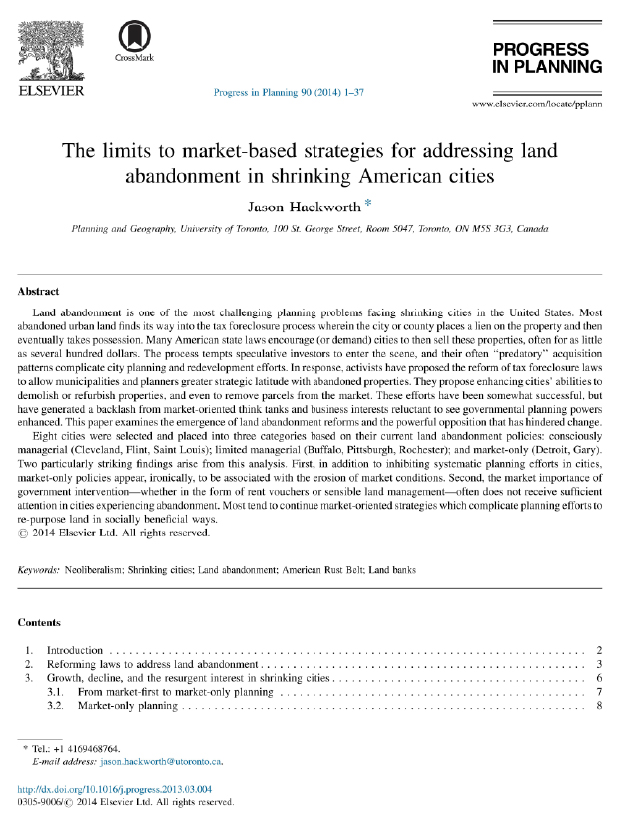Abandonment
n. The state or condition of being abandoned by a person or people; an instance of this. Being abandoned is to be given up, to the control or discretion of another, or to be relinquished entirely.Podcasts
Department of Housing and Urban Development. "PD&R Quarterly Briefing: Challenge and Opportunity of Vacancy". HUD Youtube Channel, April 10, 2014. Video, 1:58:55. https://www.youtube.com/watch?v=FiETZZf-UR8&feature=youtu.be.
Heltman, John. "Dead Pledge: The Rise and Fall of Urban Homesteading". The American Banker, Nobody's Home, Ep. 2, November 2018. Audio, 30:07. https://www.americanbanker.com/nobodyshome#group-episode-2-dh9k47eS0J
Heltman, John. "Marshall Plan: How to Fix Vacant Housing ". The American Banker, Nobody's Home, Ep. 9, December 2018. Audio, 44:57. https://www.americanbanker.com/nobodyshome#group-episode-9-ptRxjR9lHO.
Pitera, Dan. “If it works, then it's obsolete.” Sasaki vimeo channel, May 4, 2011. Video, 1:23:09. https://vimeo.com/26013981.Williams, Amanda. "Why I turned Chicago's abandoned homes into art". Filmed November, 2018. TED video, 13:22. https://www.ted.com/talks/amanda_williams_why_i_turned_chicago_s_abandoned_homes_into_art?language=en.
Texts and other related media
Arsen, David. “Property Tax Assessment Rates and Residential Abandonment.” American Journal of Economics and Sociology 51, no. 3 (1992): 361-377. Berube, Alan. “SMALL and MIDSIZED LEGACY COMMUNITIES: Trends, assets, and principles for action.” Metropolitan Policy Program at Brookings, November 2019. https://www.brookings.edu/research/small-and-midsized-legacy-communities-trends-assets-and-principles-for-action/
Bowman, Ann O'M, and Michael A. Pagano. Terra Incognita: Vacant Land and Urban Strategies. Washington, D.C.: Georgetown University Press, 2004.
Bowring, Jacky. A Field Guide to Melancholy. United Kingdom: Oldcastle Books, 2011.
Donovan, Michael T. "The Abandonment of Real Estate Projects." Real Estate Taxation 36, no. 4 (2009): 148-163.
Gordon, Colin. "Patchwork Metropolis: Fragmented Governance and Urban Decline in Greater St. Louis." Saint Louis University Public Law Review 34, no. 1 (2014): 51-70. https://scholarship.law.slu.edu/cgi/viewcontent.cgi?article=1050&context=plr Gordon, Colin. “St. Louis Blues: The Urban Crisis in the Gateway City,” 33 St. Louis University Public Law Review, 33/81, 2013: 81–92. https://scholarship.law.slu.edu/cgi/viewcontent.cgi?article=1081&context=plr
Hackworth, Jason. "The Limits to Market-based Strategies for Addressing Land Abandonment in Shrinking American Cities." Progress in Planning 90 (2014): 1-37.
Hackworth, Jason. "The Limits to Market-based Strategies for Addressing Land Abandonment in Shrinking American Cities." Image. Progress in Planning 90, 2014.
Hillier, Amy E., Dennis P. Culhane, Tony E. Smith, & Charles Dana Tomlin. “Predicting Housing Abandonment with the Philadelphia Neighborhood Information System.” Journal of Urban Affairs 25, no. 1 (2003): 91-106. https://repository.upenn.edu/cgi/viewcontent.cgi?article=1006&context=cplan_papers
Hollander, Justin B. "Moving Toward a Shrinking Cities Metric: Analyzing Land Use Changes Associated With Depopulation in Flint, Michigan." Cityscape 12, no. 1 (2010): 133-51. www.jstor.org/stable/20868735.
Hollander, Justin, Colin Polsky, Dan Zinder, & Dan Runfola. “The New American Ghost Town: Foreclosure, Abandonment, and the Prospects for City Planning.” Lincoln Institute of Land Policy Working Papers, 2010. http://www.lincolninst.edu/pubs/1858_TheNew-American-Ghost-Town
Hollander, Justin B., and Jeremy Németh. "The Bounds of Smart Decline: A Foundational Theory for Planning Shrinking Cities." Housing Policy Debate 21, no. 3 (2011): 349-67.
Holway, Jim, Don Elliott, & Anna Trentadue. “Combating Zombie Subdivisions: How Three Communities Redressed Excess Entitlements.” Land Lines Magazine, January 2014. https://www.lincolninst.edu/publications/articles/combating-zombie-subdivisions
J. Max Bond Center. “Mapping America’s Legacy Cities 2015.” City College of New York, 2015. https://ssa.ccny.cuny.edu/wp-content/uploads/2015/12/MappingAmericanLegacyCities_15Dec2015.pdf
Lanks, Belinda. “Creative Shrinkage.” New York Times Magazine, December 10, 2006. https://www.nytimes.com/2006/12/10/magazine/10section1B.t-3.html
López-Piñeiro, Sergio. A Glossary of Urban Voids. Berlin: Jovis Verlag, 2020. Excerpts.
López-Piñeiro, Sergio. “A Glossary of Urban Voids Title Page.” Image. Berlin: Jovis Verlag, 2020.
Mallach, Alan, Lavea Brachman. “Regenerating America’s Legacy Cities.” Lincoln Institute of Land Policy, 2013. https://www.lincolninst.edu/sites/default/files/pubfiles/regenerating-legacy-cities-full_0.pdf
Morckel, Victoria. “Empty Neighborhoods: Using Constructs to Predict the Probability of Housing Abandonment.” Housing Policy Debate 23, no .3 (2013): 469-496. Ryan, Brent D. and Lorena Bello. “The Fiscal Topography of the Shrinking City.” Prospecta 47: Money, The Yale Architectural Journal (2014): 199-205. https://architecture.mit.edu/sites/architecture.mit.edu/files/attachments/project/Ryan_Bello_article.pdf
Solà-Morales Rubió, Ignasi. “Terrain Vague.” In Anyplace, ed. Cynthia Davidson. New York: Anyone and The MIT Press, 1995: 118–123. Access from HathiTrust. https://esquerdadireitaesquerda.files.wordpress.com/2014/04/terrain-vague-sola-morales-21.pdfSwope, Christopher. “Smart Decline.” Governing Magazine, November 2006. http://www.governing.com/topics/economic-dev/Smart-Decline.html
The New York Public Library Editors. “Home.” In Motion: The African-American Migration Experience. Updated 2019. http://www.inmotionaame.org/about.cfm
Webley, Curtis. “Taxation of Abandonment.” Journal of Accountancy 213, no. 3 (2012). https://www.journalofaccountancy.com/issues/2012/mar/20114907.html

